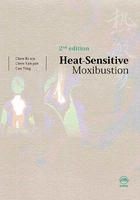
3 HSM Manipulations
HSM uses moxa sticks to administer suspended moxibustion, which can be further divided into single-point mild moxibustion, double-point mild moxibustion, triangle mild moxibustion, relaying mild moxibustion and back-and-forth moxibustion along the channel.
Single-point Mild Moxibustion
This method involves administering moxibustion on a single heat-sensitized acupoint, keeping the burning moxa stick about 3 cm away from the skin or at a distance that is not painful to the patient. This method activates the channel qi in the area receiving moxibustion, induces transmission of channel qi and unblocks the collaterals. Moxibustion should be administered until the heat-sensitive sensation disappears (more on dosage below),no matter how long this takes. (Fig. 2-5)

Double-point Mild Moxibustion
This method involves administering moxibustion simultaneously to two heatsensitive acupoints with moxa sticks, and can be further divided into single-hand and double-hand techniques. Manipulations includes circling, sparrow-pecking, back-andforth and mild moxibustion. Double-point moxibustion induces transmission of channel qi and unblocks the collaterals. Moxibustion should be administered until the heat-sensitive sensation disappears, no matter how long this takes. (Fig. 2-6, Fig. 2-7)


Triangle Mild Moxibustion
This method involves administering moxibustion in a triangle or T shape to three heat-sensitive acupoints simultaneously. Manipulations include circling, sparrow-pecking,back-and-forth and mild moxibustion. This method can be used on the neck, back,lumbar area, chest and abdomen. The following combinations are commonly used:bilateral GB 20 (fēng chí) and GV 14 (dà zhuī); bilateral BL 23 (shèn shù) and GV 3 (yāo yáng guān); and bilateral ST 25 (tiān shū) and CV 4 (guān yuán). Triangle mild moxibustion induces transmission of channel qi, and unblocks the channels and collaterals. Moxibustion should be administered until the heat-sensitive sensation disappears. (Fig. 2-8, Fig. 2-9)


Relaying Mild Moxibustion
If the above moxibustion methods serve to locate heat-sensitive acupoints but do not cause satisfactory transmission of channel qi, moxibustion should be administered at another point further along the channel from the heat-sensitized acupoint to encourage the sensation to reach the affected area. This extends the route of channel qi transmission.(Fig. 2-10)

Back-and-forth Moxibustion along the Channel
This method can be used to explore for heat-sensitive acupoints, as well as for treatment. Keeping a burning moxa stick 3 cm from the skin, move it back and forth along the channel at an even pace. The patient should feel warmth along the path of the moxa stick. This technique dredges the channels, unblocks the collaterals and activates channel qi. It is suitable for patients with deficient qi in which the transmission of channel qi is not obvious or smooth. For example, in stroke patients this method can be used on the affected side of the body.(Fig. 2-11)
